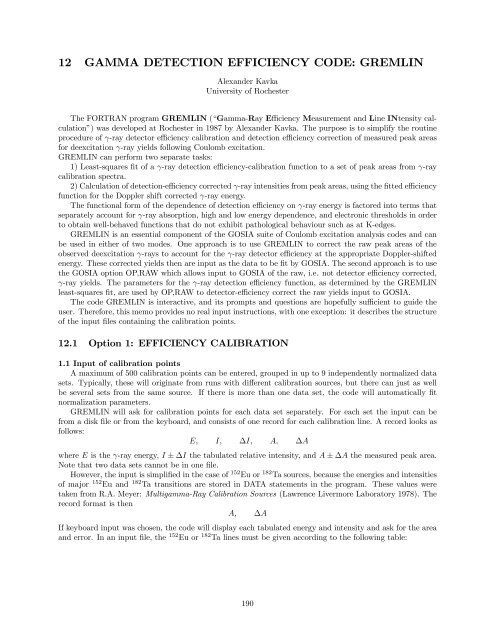coulomb excitation data analysis codes; gosia 2007 - Physics and ...
coulomb excitation data analysis codes; gosia 2007 - Physics and ...
coulomb excitation data analysis codes; gosia 2007 - Physics and ...
Create successful ePaper yourself
Turn your PDF publications into a flip-book with our unique Google optimized e-Paper software.
12 GAMMA DETECTION EFFICIENCY CODE: GREMLINAlex<strong>and</strong>er KavkaUniversity of RochesterThe FORTRAN program GREMLIN (“Gamma-Ray Efficiency Measurement <strong>and</strong> Line INtensity calculation”)was developed at Rochester in 1987 by Alex<strong>and</strong>er Kavka. The purpose is to simplify the routineprocedure of γ-ray detector efficiency calibration <strong>and</strong> detection efficiency correction of measured peak areasfor de<strong>excitation</strong> γ-ray yields following Coulomb <strong>excitation</strong>.GREMLIN can perform two separate tasks:1) Least-squares fit ofaγ-ray detection efficiency-calibration function to a set of peak areas from γ-raycalibration spectra.2) Calculation of detection-efficiency corrected γ-ray intensities from peak areas, using the fitted efficiencyfunction for the Doppler shift corrected γ-ray energy.The functional form of the dependence of detection efficiency on γ-ray energy is factored into terms thatseparately account for γ-ray absorption, high <strong>and</strong> low energy dependence, <strong>and</strong> electronic thresholds in orderto obtain well-behaved functions that do not exhibit pathological behaviour such as at K-edges.GREMLIN is an essential component of the GOSIA suite of Coulomb <strong>excitation</strong> <strong>analysis</strong> <strong>codes</strong> <strong>and</strong> canbe used in either of two modes. One approach is to use GREMLIN to correct the raw peak areas of theobserved de<strong>excitation</strong> γ-rays to account for the γ-ray detector efficiency at the appropriate Doppler-shiftedenergy. These corrected yields then are input as the <strong>data</strong> to be fit by GOSIA. The second approach is to usethe GOSIA option OP,RAW which allows input to GOSIA of the raw, i.e. not detector efficiency corrected,γ-ray yields. The parameters for the γ-ray detection efficiency function, as determined by the GREMLINleast-squares fit, are used by OP,RAW to detector-efficiency correct the raw yields input to GOSIA.The code GREMLIN is interactive, <strong>and</strong> its prompts <strong>and</strong> questions are hopefully sufficient to guide theuser. Therefore, this memo provides no real input instructions, with one exception: it describes the structureof the input files containing the calibration points.12.1 Option 1: EFFICIENCY CALIBRATION1.1 Input of calibration pointsA maximum of 500 calibration points can be entered, grouped in up to 9 independently normalized <strong>data</strong>sets. Typically, these will originate from runs with different calibration sources, but there can just as wellbe several sets from the same source. If there is more than one <strong>data</strong> set, the code will automatically fitnormalization parameters.GREMLIN will ask for calibration points for each <strong>data</strong> set separately. For each set the input can befrom a disk file or from the keyboard, <strong>and</strong> consists of one record for each calibration line. A record looks asfollows:E, I, ∆I, A, ∆Awhere E is the γ-ray energy, I ± ∆I the tabulated relative intensity, <strong>and</strong> A ± ∆A the measured peak area.Note that two <strong>data</strong> sets cannot be in one file.However, the input is simplified in the case of 152 Eu or 182 Ta sources, because the energies <strong>and</strong> intensitiesof major 152 Eu <strong>and</strong> 182 Ta transitions are stored in DATA statements in the program. These values weretaken from R.A. Meyer: Multigamma-Ray Calibration Sources (Lawrence Livermore Laboratory 1978). Therecord format is thenA, ∆AIf keyboard input was chosen, the code will display each tabulated energy <strong>and</strong> intensity <strong>and</strong> ask for the area<strong>and</strong> error. In an input file, the 152 Eu or 182 Ta lines must be given according to the following table:190
















